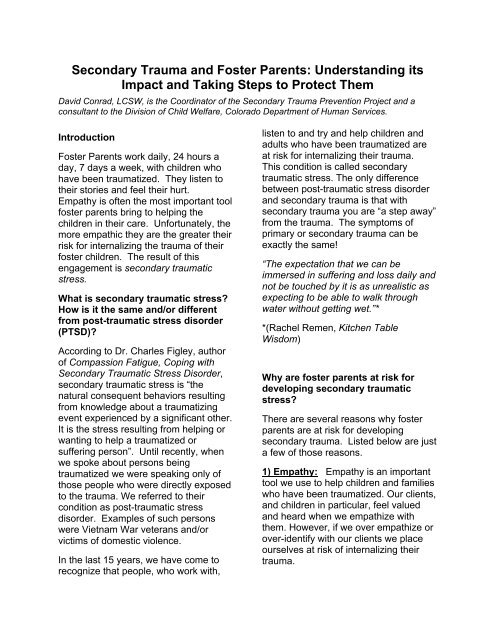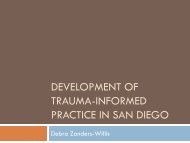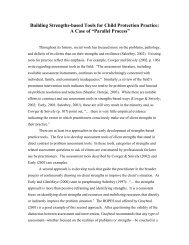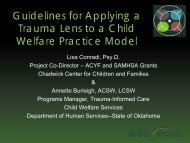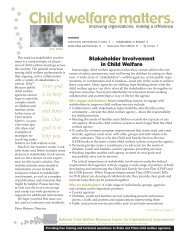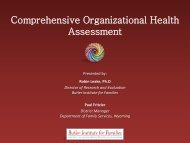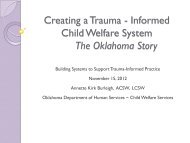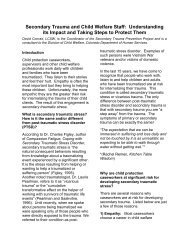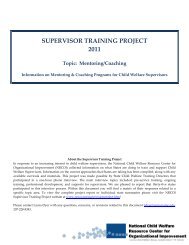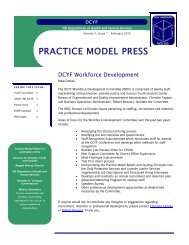Secondary Trauma and Foster Parents: Understanding its Impact ...
Secondary Trauma and Foster Parents: Understanding its Impact ...
Secondary Trauma and Foster Parents: Understanding its Impact ...
Create successful ePaper yourself
Turn your PDF publications into a flip-book with our unique Google optimized e-Paper software.
<strong>Secondary</strong> <strong>Trauma</strong> <strong>and</strong> <strong>Foster</strong> <strong>Parents</strong>: Underst<strong>and</strong>ing <strong>its</strong><br />
<strong>Impact</strong> <strong>and</strong> Taking Steps to Protect Them<br />
David Conrad, LCSW, is the Coordinator of the <strong>Secondary</strong> <strong>Trauma</strong> Prevention Project <strong>and</strong> a<br />
consultant to the Division of Child Welfare, Colorado Department of Human Services.<br />
Introduction<br />
<strong>Foster</strong> <strong>Parents</strong> work daily, 24 hours a<br />
day, 7 days a week, with children who<br />
have been traumatized. They listen to<br />
their stories <strong>and</strong> feel their hurt.<br />
Empathy is often the most important tool<br />
foster parents bring to helping the<br />
children in their care. Unfortunately, the<br />
more empathic they are the greater their<br />
risk for internalizing the trauma of their<br />
foster children. The result of this<br />
engagement is secondary traumatic<br />
stress.<br />
What is secondary traumatic stress?<br />
How is it the same <strong>and</strong>/or different<br />
from post-traumatic stress disorder<br />
(PTSD)?<br />
According to Dr. Charles Figley, author<br />
of Compassion Fatigue, Coping with<br />
<strong>Secondary</strong> <strong>Trauma</strong>tic Stress Disorder,<br />
secondary traumatic stress is “the<br />
natural consequent behaviors resulting<br />
from knowledge about a traumatizing<br />
event experienced by a significant other.<br />
It is the stress resulting from helping or<br />
wanting to help a traumatized or<br />
suffering person”. Until recently, when<br />
we spoke about persons being<br />
traumatized we were speaking only of<br />
those people who were directly exposed<br />
to the trauma. We referred to their<br />
condition as post-traumatic stress<br />
disorder. Examples of such persons<br />
were Vietnam War veterans <strong>and</strong>/or<br />
victims of domestic violence.<br />
In the last 15 years, we have come to<br />
recognize that people, who work with,<br />
listen to <strong>and</strong> try <strong>and</strong> help children <strong>and</strong><br />
adults who have been traumatized are<br />
at risk for internalizing their trauma.<br />
This condition is called secondary<br />
traumatic stress. The only difference<br />
between post-traumatic stress disorder<br />
<strong>and</strong> secondary trauma is that with<br />
secondary trauma you are “a step away”<br />
from the trauma. The symptoms of<br />
primary or secondary trauma can be<br />
exactly the same!<br />
“The expectation that we can be<br />
immersed in suffering <strong>and</strong> loss daily <strong>and</strong><br />
not be touched by it is as unrealistic as<br />
expecting to be able to walk through<br />
water without getting wet.”*<br />
*(Rachel Remen, Kitchen Table<br />
Wisdom)<br />
Why are foster parents at risk for<br />
developing secondary traumatic<br />
stress?<br />
There are several reasons why foster<br />
parents are at risk for developing<br />
secondary trauma. Listed below are just<br />
a few of those reasons.<br />
1) Empathy: Empathy is an important<br />
tool we use to help children <strong>and</strong> families<br />
who have been traumatized. Our clients,<br />
<strong>and</strong> children in particular, feel valued<br />
<strong>and</strong> heard when we empathize with<br />
them. However, if we over empathize or<br />
over-identify with our clients we place<br />
ourselves at risk of internalizing their<br />
trauma.
2) Insufficient Recovery Time: <strong>Foster</strong><br />
parents often listen to their foster<br />
children describe some horrific events<br />
they have experienced. In addition,<br />
foster parents often hear the same or<br />
similar horror stories over <strong>and</strong> over<br />
again. With children in their home 24<br />
hours a day, 7 days a week, they are<br />
often deprived of the “time off” they<br />
need to heal or to get some distance<br />
from what they have heard. <strong>Secondary</strong><br />
trauma is cumulative, so listening to<br />
these stories over <strong>and</strong> over again can<br />
have a negative effect on even the most<br />
compassionate <strong>and</strong> resilient foster<br />
parents.<br />
3) Unresolved Personal <strong>Trauma</strong>:<br />
Many foster parents have had some<br />
personal loss or even traumatic<br />
experience in their own life (e.g., loss of<br />
a family member, death of a close<br />
friend, physical or emotional abuse). To<br />
some extent, the pain of their own<br />
experience(s) can be "re-activated"<br />
when they hear the child describe a<br />
traumatic situation similar to the one<br />
they experienced. Unless the foster<br />
parent has healed from their own<br />
trauma they are at increased risk for<br />
internalizing the trauma of their foster<br />
child.<br />
4) Children are the Most Vulnerable<br />
Members of Our Society: Young<br />
children are completely dependent on<br />
adults for their emotional <strong>and</strong> physical<br />
needs. When adults maltreat children, it<br />
evokes a strong reaction in any person<br />
who cares about children. As the<br />
primary caretakers for vulnerable<br />
children, foster parents are at increased<br />
risk for having a strong emotional<br />
reaction to what they hear <strong>and</strong> learn<br />
about from these children. The inability<br />
of the foster parents to change the<br />
situation can make them feel even more<br />
vulnerable (Figley, 1995)<br />
How do you know if you are suffering<br />
from secondary traumatic stress?<br />
One of the most difficult tasks for a<br />
foster parent is to recognize if they are<br />
suffering from secondary traumatic<br />
stress. Every person reacts differently<br />
<strong>and</strong> copes differently with their reaction<br />
to adversity. What one person finds<br />
helpful may not be helpful for another<br />
person <strong>and</strong> vice versa. All people must<br />
remember to call on the coping<br />
mechanisms that work best for them.<br />
There are, however, several "individual<br />
indicators of distress" which can tell us<br />
that we are at increased risk for<br />
developing secondary trauma. A key<br />
indicator is when you find yourself acting<br />
<strong>and</strong> feeling in ways that don’t feel<br />
normal to you. It is normal for all of us to<br />
have a range of emotions that include<br />
anger, sadness, depression or anxiety.<br />
However, when these emotions become<br />
more extreme or prolonged than usual,<br />
it is a potential indicator of distress (see<br />
table below).<br />
When you begin to see or feel, in<br />
yourself, emotional or physical<br />
indicators of extreme distress, it is time<br />
to step back <strong>and</strong> evaluate yourself. Are<br />
there specific images or cases that keep<br />
coming into your head again <strong>and</strong> again?<br />
Are there situations with children that<br />
provoke anxiety that you are trying to<br />
avoid? Are there situations or people<br />
that remind you of a particularly<br />
distressing case? If you are<br />
experiencing some of these indicators,<br />
on a consistent basis, you should reach<br />
out <strong>and</strong> ask for help from another foster<br />
parent or from your caseworker. If the<br />
trauma symptoms become severe <strong>and</strong><br />
last for more than a few days, you
should consider seeing a therapist who<br />
specializes in trauma work.<br />
Emotional Indicators<br />
Anger<br />
Sadness<br />
Prolonged Grief<br />
Anxiety<br />
Physical Indicators<br />
Headaches<br />
Stomach aches<br />
Back aches<br />
Exhaustion<br />
Personal Indicators<br />
Self-isolation<br />
Cynicism<br />
Mood swings<br />
Irritability<br />
Self-Care Strategies for Combating<br />
<strong>Secondary</strong> <strong>Trauma</strong> Stress<br />
Underst<strong>and</strong>ing your own needs <strong>and</strong><br />
responding appropriately is of<br />
paramount importance in combating<br />
secondary traumatic stress. For foster<br />
parents it is critically important to find<br />
ways to “get a break” from parenting. To<br />
avoid feeling overwhelmed by feelings<br />
of frustration <strong>and</strong> sadness it is important<br />
to engage in activities you consider fun<br />
<strong>and</strong> playful. Any person working with<br />
maltreated or traumatized children<br />
needs to set aside time to rest,<br />
emotionally <strong>and</strong> physically, <strong>and</strong> to<br />
engage in activities that restore their<br />
sense of hope<br />
Remember, in the end, our ability to<br />
help children who have suffered<br />
depends upon our ability to care for<br />
ourselves….physically, emotionally,<br />
socially <strong>and</strong> spiritually, so we can be<br />
there for them when they need us.<br />
the following passage by Marc Parent is<br />
his book, Turning Stones: My Days <strong>and</strong><br />
Nights with Children at Risk.<br />
“Rescuing one child from the harm of<br />
one night is glorious success. The<br />
evening is an opportunity to touch a life<br />
at a critical moment <strong>and</strong> make it<br />
better—not for a lifetime, not even for<br />
tomorrow, but for one moment. One<br />
moment—not to talk, but to act—not to<br />
change the world, but to make it better.<br />
It’s all that can be done <strong>and</strong> not only is<br />
that enough—that’s brilliant.”*<br />
Recommended Reading<br />
Figley, C.R. (Ed.) (1995). Compassion<br />
fatigue: Coping with secondary<br />
traumatic stress in those who treat the<br />
traumatized. New York: Brunner/Mazel.<br />
Stamm, B.H. (1995). <strong>Secondary</strong><br />
traumatic stress: Self-care issues for<br />
clinicians, researchers, <strong>and</strong> educators.<br />
Maryl<strong>and</strong>: Sidran Press.<br />
Herman, J. (1997). <strong>Trauma</strong> <strong>and</strong><br />
Recovery. New York: BasicBooks.<br />
Parent, M. (1996). Turning Stones: My<br />
Days <strong>and</strong> Nights with Children at Risk.<br />
New York: Ballantine<br />
About the Author<br />
David Conrad has been a social worker for<br />
over 30 years. He has worked as a child<br />
protection caseworker <strong>and</strong> supervisor. He<br />
currently serves as a Senior Instructor with<br />
JFK Partners/Department of Pediatrics at<br />
the University of Colorado Health Sciences<br />
Center in Denver, Colorado. To learn more<br />
about secondary trauma or to talk with him<br />
about providing secondary trauma training,<br />
please contact him at<br />
Conrad.David@tchden.org or at 303-861-<br />
6183.<br />
Let me close by saying, in approaching<br />
your work please listen to the wisdom of


